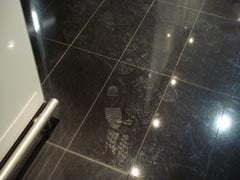In this regular column, Consultant Barry Hunt answers reader enquiries. If you have a question, email it to: nss@qmj.co.uk marked for Barry’s attention.
Q: I have laid several black granite floors and they always seem to show marks. Do you have any advice?
I first wrote about black natural stone floors almost 20 years ago and my advice has not changed since then: don’t have them unless you are prepared to put up with more intensive maintenance.
This is the same problem that the owners of black cars complain about and stems from how dirt seems to show up more on black than on other colours. The problem starts with why a surface appears black in the first instance.
Light falling on a surface is initially absorbed by it and then internally reflected for various reasons. Black materials are those where very little light is reflected, the majority being absorbed, while white materials reflect almost all the incident light.
Surface dust and scratching interfere with the light path, preventing absorption. Now reflected light scatters, typically as white light. Thus the more scratching and dust, the greater the amount of light reflected and not absorbed and the lighter the surface appears.
When the surface is white, the difference in appearance is typically minimal because such material already reflects most of the incident light.
The problem is amplified in highly polished black stones through a phenomenon known as ‘matting up’, where the polished surface becomes lighter and consequently usually greyer as it wears and becomes finely scratched.
This can sometimes happened in a matter of weeks in highly trafficked areas such as office entrance lobbies. The effect often appears worse because it highlights trafficking patterns, often referred to as ‘tracking’.
Areas where people are channelled through security barriers, or where they stand and then turn in front of vending machines are typical examples of where a floor may become lighter in appearance.
On a more day-to-day basis, a variety of problems may dramatically and quickly affect the appearance of black stones. Moisture brought in from the outside may include salts that can leave thin nebulous deposits sometimes called ‘water marks’ when they dry.
Canteen and kitchen areas typically suffer from the spillage of foodstuffs containing oils that will create a greasy, smeared appearance which is difficult to remove completely using standard maintenance.
Finally, dirt and dust derived from office equipment, concrete floors, gardens and many other sources will just sit on the surface and will have an immediate effect on appearance. If dust is an on-going or regular problem the floor will rarely appear clean.
Unfortunately, you have to accept that a polished black stone floor will always be more difficult to maintain than one of lighter colour. So the only tips I can offer are ways to help minimise the factors that alter stone appearance. Dirt and moisture can be reduced by increasing the area of matting at entry points and having procedures to remove wet clothing and shoes, though in commercial and public areas this will not be possible. Trays should be used in canteen areas, though this is typically standard. Where tracking occurs, finishes may be restored using specialist dyes and / or waxes, possibly in combination with burnishing processes such as ‘crystallisation’, but this is the realm of the specialist stone cleaning contractor.
Those who are not discouraged by a labour of love might consider a finish such as flame-texturing. Such finishes will be less susceptible to lightening issues arising from the factors discussed.

